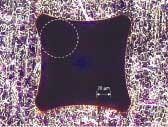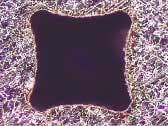Shrinking diameters
Recent developments have made it possible to cut stencil masks, stents, and other products in thin, sheet metals with very high precision and minimal heat affects due to the waterjet-guided laser. A waterjet-guided laser called Laser-Microjet is now available in jet diameters down to 28 microns—able to cut corner radii of 14 microns. The laser cuts while assisted by a waterjet guiding the focused laser beam directly to the workpiece. The pressure of the waterjet ensures efficient material removal, and furthermore, instantaneously cools the edges after each laser pulse. The laser spot size on the material surface remains constant, even deep within the cut. As a result, waterjet-guided laser cuts have exceptional parallelism when carried out with appropriate parameters.
The Laser-Microjet utilizes a low-pressure waterjet as a liquid optical fiber to guide the focused laser beam onto the workpiece. In the past, waterjet diameters were available between 50 and 150 µm. Recent breakthroughs at Synova (Ecublens, Switzerland) have reduced diameters to 28 µm, which is now the thinnest microjet commercially available. In comparison, a human hair has a diameter of 50–100 µm.
One of the targeted applications for the ultra-thin microjet is the cutting and drilling of stencils and wafer bump stencils in stainless steel. A stencil is a mask used for the application of solder paste on printed circuit boards. The wafer bump stencil is a stencil with smaller apertures used in flip-chip technology to apply solder paste directly on a bare chip. Apertures in stencils vary from a millimeter in size to a few hundredths of a millimeter with varying shapes: round holes, squares, and so on. All of them benefit from the new smaller tool radius. The squares have sharper corners and smaller round holes can be cut. From a quality point of view, it's advantageous to cut the holes with trepanning rather than percussion. Trepanning quality is now achieved for hole diameters down to 50 µm in thin materials, where previously percussion drilling was required. Percussion is faster, but applicable only for very thin sheets, and at the expense of hole roundness. Consequentially, the 28-µm microjet is, by rights of cutting size reduction alone, an attractive tool for stencil makers in cases where holes down to 50 µm are common.
Figures 1 and 2 show a concave hole in a stencil cut with Laser-Microjet in 300 ms, corresponding to a rate exceeding 10,000 apertures per hour. The stencil material was an 80-µm thick stainless steel sheet, and the total width of the aperture is 120 µm. For years, Laser-Microjet has been available with 50-µm waterjets and larger. The dashed circle has a diameter corresponding to 50 µm to indicate the difference.
As dimensions become smaller, the heat-affected zone (HAZ) becomes increasingly prevalent. Laser-Microjet takes advantage of the waterjet for material removal and efficient cooling of the cut edges. The stencil aperture in Figure 2 was cut with waterjet pressure of 20 MPa (200 bars), corresponding to a waterjet speed on the order of 200 m/s, providing substantial cooling to the cut edges. HAZ is virtually undetectable in the workpiece. The waterjet-guided laser can be considered for practical purposes as a 'cold' laser beam, leaving zero or minimal traces of heating. The stencil mask in Figures 1 and 2 has been washed only in de-ionized water.
Wafer dicing, cutting dies out of wafers, is another growing application in which the industry seeks narrower cutting widths. Therefore, numerous companies in the semiconductor industries are interested in the possibilities offered by the new microjet. Narrower streets (the scribe lane between the dies on a wafer) are the future as the dies become ever smaller. Synova is currently developing a 17-µm microjet to meet future requirements, such as those in the opto-semiconductor sector with small die, such as LEDs having areas smaller than 1mm2. As streets are narrowed, additional dies can be packed on the wafer, adding value to each wafer. Streets are basically lost area on the wafer and when you cut narrower, you cut costs.
The waterjet works with pressures typically ranging from 20–40 MPa, thus high enough to remove all molten material while keeping the cut clean, and at the same time, low enough to leave the material unscathed when exposed to the bare jet. Only the laser beam cuts the material.
Wall cooling, in addition, is an important function of the waterjet, as any residual heat in the workpiece is absorbed instantly between laser pulses by the high-speed jet. Conventional laser processes do not have this possibility. Due to its small diameter, the microjet exerts an external force on the workpiece consistently less than 0.01 N. Nevertheless, the pressure is pivotal in efficiently removing all molten material. The low force keeps the workpiece stable and fixed without oscillations, making it possible to reach the highest quality and positioning accuracy.
There is a growing industrial need for cutting and drilling thin materials with increasingly narrower kerfs. The waterjet-guided laser cuts thin materials (metals, semiconductors, and so on) with narrow, clean kerfs and with minimal or even undetectable heat effects within material.
For further information, contact Thomas Nilsson, Synova S.A., at e-mail [email protected] or visit www.synova.ch .



